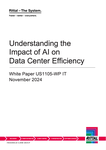Imagine a wild stallion (AI) galloping ahead, followed closely by a herd of once-tame, now unpredictable horses (emerging tech), charging across the rugged plains of the Wild West (the data center industry). Spectators look on, realizing the need for action, but the rush of the herd is so compelling that it’s hard to resist joining in. Amidst this chaos stands Herb Villa, senior solutions architect for data center solutions at Rittal – our seasoned wrangler, ready to take charge.
Here, DCD uncovers why Villa hopes to empower industry leaders to pause, reassess the data center landscape, and avoid letting AI run wild.
Stop, look, listen
Since the days when four megabits per second was considered fast and five kilowatts defined as high density, Villa has been immersed in the data center industry, watching it evolve from the basic computer room to the complex data centers we know today.
With his extensive experience, Villa reflects on the growing impact of AI – from its early days as a buzzword to its current role in large-scale transformations that are reshaping not just our imaginations, but our everyday experiences with AI-driven technologies.
As an active member of several industry organizations, including ASHRAE, The Green Grid, and AFCOM, Villa makes a conscious effort to help align industry regulations with reality. Given this background, Villa takes a moment to assess the evolution of data center infrastructure:
“Chaotic. It’s always been chaotic. When I was a data center instructor, I’d ask my students who wanted to be data center managers, and not a single hand went up. I’d ask how many had any formal data center training, and again, no hands. It’s been an ad hoc journey.”
“Even today, there are competing standards, goals, and metrics, but everyone is still doing their own thing,” Villa adds.
Villa notes that the definition of “cutting-edge” has changed dramatically over the years, with companies once chasing the latest advancements often finding themselves left behind, sometimes going out of business as a result.
“Today, companies strive to go beyond ‘cutting-edge,’ but they don’t actually know what that means. Sure, there are plans, but it’s still haphazard. Roadblocks remain – power availability, thermal challenges, global warming, and climate change.”
Taking it all in, Villa’s message is clear: Before diving headfirst into AI-driven infrastructure, should the industry take a step back, assess the landscape, and approach the future more thoughtfully?
Rein it in
Before making drastic changes, it’s wise to first assess the situation and determine the best course of action. AI enthusiasm is widespread, but Villa warns against overestimating its role or hastily reshaping the industry to accommodate it. One major risk is losing control:
“Losing control, both physically and cyber-wise, is an enormous concern. Today’s applications open doors – not just the front doors, but back doors too. I don’t think we fully realize how dependent we are – accountability, control, capability, and manageability are critical in AI-supported applications, from remote monitoring of hospital patients to air traffic control and self-driving vehicles.”
To illustrate this point, Villa references historical milestones like the Wright Brothers’ first flight, Thomas Edison’s inventions, Alexander Graham Bell’s telephone, and Henry Ford’s assembly line – groundbreaking advancements that didn’t happen overnight. Just as aviation and space exploration took more than a century of gradual improvement, AI must be carefully managed.
Resetting the pace
Having taken stock of the situation and regained control, it’s worth asking how industry players can refine their thinking to stay on course, embracing the principle of "just because I can, doesn’t mean I should.”
Villa emphasizes the importance of stopping the competition – halting the race for dominance. Drawing from experience, he highlights the obsession with outdoing others on the power usage effectiveness (PUE) metric:
“PUE is a benchmark – something to ask, 'Can I improve on it?' Not ‘Can I do better than the guy next door?’ Don’t just chase something because everyone else is doing it, because your boss says you should, or because customers expect it.”
Villa clarifies that his recommendations are not a critique of AI itself. He acknowledges the value of AI applications, and despite occasional hiccups (much like human errors), he encourages companies to continue developing AI.
However, he advocates for a more balanced, thoughtful approach:
“I go back to the evolution, the timing, the cost involved – not just in development, but also infrastructure costs, software costs, personnel costs, environmental impact, and social costs.”
The goal isn’t to halt AI progress, but to ensure it advances responsibly, avoiding reckless development without proper management.
Energy in the Wild West
As data centers expand and AI adoption accelerates, energy consumption is soaring at an overwhelming rate. This adds an extra layer of responsibility for industry players to balance performance demands with sustainability, ensuring power resources are used efficiently without overloading infrastructure or exhausting their horsepower.
Established data center markets, like the US and parts of Europe, are struggling to maintain control over energy resources, while emerging markets are also increasingly entering the scene. As demand rises, energy availability becomes a critical factor in either widening or bridging the digital divide – across cities, countries, and entire regions.
High-density workloads, particularly those driven by AI, require innovative cooling solutions and alternative energy sources to maintain uptime while minimizing environmental impact. Villa notes:
“We can’t provide power and cooling effectively if we ignore the broader impact – whether due to local political climates or the environmental consequences of global warming and climate change. The responsibility is now.”
“Data centers will continue to gobble up an enormous amount of electricity. The opportunity is for the data center space to be a responsible industry in providing services effectively, safely, and to reduce that digital divide,” he emphasizes.
With increasing strain on power grids, failing to manage energy wisely could lead to disruptions, inefficiencies, and unfeasible costs. Thus, a strategic, responsible approach to energy use is critical in shaping the future of data center infrastructure.
Drawing from his experience with nuclear power in the US Navy, Villa argues that while nuclear power is important for the energy mix, deploying small reactors near data centers is not a viable solution. Public resistance to hazardous infrastructure in residential areas and lengthy approval processes for nuclear plants ultimately means the industry must rethink its energy strategy.
Navigating uncharted territory
One of the biggest industry questions is how to future-proof facilities. The difficulty with planning for the future is that, by definition, it hasn’t happened yet – meaning everything is subject to change. Villa acknowledges that while industries have a general sense of direction, predicting specific outcomes is impossible. Still, that doesn’t mean we should stop looking ahead:
“We all plan for things – whether it’s retirement, having a child, going to school, or landing a new job. That’s important. However, we also need to learn from both the present and the past to understand how we got here.”
A call for thoughtful progress
Rather than blindly chasing AI-driven transformation, Villa urges the industry to take a measured, considerate approach. Data centers, AI applications, and supporting infrastructure must evolve responsibly to balance innovation with control, sustainability, and ambition with foresight. The question isn’t whether AI has a role to play, but whether the industry is truly prepared to manage it wisely.
Ready to rein in the future of data centers? Discover how Rittal's expert solutions can help you navigate the evolving landscape of AI and emerging technologies here.
More from Rittal
-

Sponsored DCD>Talks: Threats to uptime in the AI era with Herb Villa, Rittal
A question of foresight and balance
-

Understanding the Impact of AI on Data Center Efficiency
Actionable steps to build data centers that are ideal for AI computing
-

Sponsored Artificial intelligence and all the buzz
Real-world challenges and necessary transformations in space, power, and cooling to support our hyperconnected future


